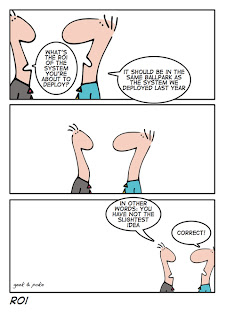The Importance of ROI When Evaluating Ancillary Business Systems

There is a general category of software based business systems that is considered mission critical to most organizations. Very few companies can operate without a general ledger package, a payroll system (or service), HRIS system, as well as industry specific systems for time and billing, manufacturing, distribution, etc. Final selection of these applications (often through an RFP process) is generally based on a combination of factors such as required functionality, ease of use, integration with other internal systems, and cost. Ultimately, regardless of whether these systems can actually save time and/or money, the business needs them and choices are made.
Where ROI (Return on Investment) analysis starts to become a greater factor in product selection is when internal business units (such as HR) are seeking out ancillary systems, sometimes referred to as “bolt-on” solutions. Examples are Data Warehouses, HR Recruiting systems, Performance Review systems, Case/ticket Management, etc. Products in this category may not be viewed as mission critical to the entire organization, but rather are considered more business critical — important primarily to the specific business group seeking the solution. In other words, the company would not shut down without them, although business operations could likely be greatly improved with them.
Compared to mission critical systems where the necessity is obvious and imminent, substantial justification is usually needed prior to budgeting for business critical applications. The business case must include analysis of many factors including:
- Clear articulation of the business problem to be resolved with the new system, and how the system will substantially achieve the stated goals
- Potential hard dollar savings (i.e., eliminating FTEs or reducing paper records for example)
- Potential soft dollar savings (i.e., time freed up for more critical work)
- Internal IT resources required to manage the system
- Integration capability with other internal systems
- Ongoing costs to support the application
- Feedback from Finance, Operations, and other departments directly or indirectly impacted by the selection
- Alternative solutions if an appropriate budget cannot be approved
Proper ROI analysis considers all of these factors and more. And a comprehensive ROI study is the key to gaining ultimate financial approval. The point here is that many companies simply equate ROI to hard dollar savings, and tackle the ROI project with that primary goal in mind. That is a huge mistake! Although demonstrating hard savings is highly beneficial to the analysis (and beloved by your friends in Finance), money is usually not the driver — productivity is.
ROI studies must therefore focus on productivity gains for the impacted department(s). For instance, a single analytical report in your HR Case Management system could point to serious problems brewing in a particular division, providing the ability for HR to resolve the problem before it hits critical mass. You cannot put a dollar savings figure on that scenario, but any good executive would fully appreciate the potential productivity loss if that issue was not discovered and addressed in a timely manner. Now multiply that example times 10 or more relevant examples and you have a compelling case to build in your ROI report. Hard dollar savings should be the icing on the cake, and not the whole cake. The more you can identify and detail real-world examples such as the one above, the less money will be factored into the final approval process.
Another element to consider is the real productivity gains derived from many systems and how these gains could impact the staffing levels in your department. There are bean counters in your organization that will recognize the potential for FTE savings, and to be fair to the organization you do need to quantify those savings in your analysis. You will have time (hopefully) to plead the case to maintain your full staff, but the report should point out ALL legitimate benefits of the new system. Remember, the goal is to win approval for the system. Be open, detailed, and honest, and if properly justified you will be on your way to modernizing and improving your department and organization. Maybe there will be ultimate financial benefits, but that is not the point, is it?
For More on ROI of HR Case Management for smaller companies download our eBook.






